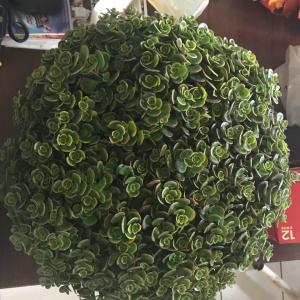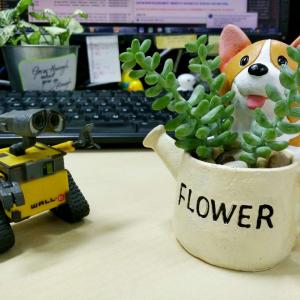文章
Dummer. ゛☀
2017年09月25日

Scientific Name
Sedum morganianum E. Walther

Common Names
Burro’s Tail, Donkey’s Tail, Lamb’s Tail, Horse’s Tail, Sedum Burrito
Scientific Classification
Family: Crassulaceae
Subfamily: Sedoideae
Tribe: Sedeae
Subtribe: Sedinae
Genus: Sedum

Flower
Color: Pink
Bloom Time: Summer
Description
Sedum morganianum is an evergreen trailing succulent with many over 2 feet (60 cm) long or more, pendent stems arising from base. The leaves are fleshy blue-green, up to 0.5 inch ( 13 mm) long, crowded along stems. Flowers readily emerge in late summer in hanging clusters of small blossoms in pink to red.

How to Grow and Care
Donkey’s Tails are pretty forgiving plants—if you forget to water them once or twice, they’ll probably be just fine. If you want your plant to really thrive, make sure to provide strong light, fertilizer during the growing season, and adequate moisture during the growing season. Too often, these are left to fend for themselves, simply because they can. But with a little effort, the plant can be a remarkable specimen.
Repot as needed, preferably during the warm season. To repot a Donkey’s Tail, make sure the soil is dry before repotting, then gently remove the pot. Knock away the old soil from the roots, making sure to remove any rotted or dead roots in the process. Treat any cuts with a fungicide. Place the plant in its new pot and backfill with potting soil, spreading the roots out as you repot. Leave the plant dry for a week or so, then begin to water lightly to reduce the risk of root rot.
Propagation is by seed or by cuttings. Individual leaves can be sprouted by placing them into a succulent or cactus potting soil, then covering the dish until they sprout. Large Donkey’s Tail plants can also be divided during repotting.
Origin
Native to Southern Mexico and Honduras.
Sedum morganianum E. Walther

Common Names
Burro’s Tail, Donkey’s Tail, Lamb’s Tail, Horse’s Tail, Sedum Burrito
Scientific Classification
Family: Crassulaceae
Subfamily: Sedoideae
Tribe: Sedeae
Subtribe: Sedinae
Genus: Sedum

Flower
Color: Pink
Bloom Time: Summer
Description
Sedum morganianum is an evergreen trailing succulent with many over 2 feet (60 cm) long or more, pendent stems arising from base. The leaves are fleshy blue-green, up to 0.5 inch ( 13 mm) long, crowded along stems. Flowers readily emerge in late summer in hanging clusters of small blossoms in pink to red.

How to Grow and Care
Donkey’s Tails are pretty forgiving plants—if you forget to water them once or twice, they’ll probably be just fine. If you want your plant to really thrive, make sure to provide strong light, fertilizer during the growing season, and adequate moisture during the growing season. Too often, these are left to fend for themselves, simply because they can. But with a little effort, the plant can be a remarkable specimen.
Repot as needed, preferably during the warm season. To repot a Donkey’s Tail, make sure the soil is dry before repotting, then gently remove the pot. Knock away the old soil from the roots, making sure to remove any rotted or dead roots in the process. Treat any cuts with a fungicide. Place the plant in its new pot and backfill with potting soil, spreading the roots out as you repot. Leave the plant dry for a week or so, then begin to water lightly to reduce the risk of root rot.
Propagation is by seed or by cuttings. Individual leaves can be sprouted by placing them into a succulent or cactus potting soil, then covering the dish until they sprout. Large Donkey’s Tail plants can also be divided during repotting.
Origin
Native to Southern Mexico and Honduras.
1
0
文章
Dummer. ゛☀
2017年09月22日

There are few plants more forgiving of sun and bad soil than Sedum plants. Growing them is easy, so easy, in fact, that even the most novice gardener can excel at it. With a large number of varieties to choose from, you will find one that works for your garden.
How to Grow Sedum
When growing Sedum, keep in mind that plants need very little attention or care. They will thrive in conditions that many other plants thrive in, but will do just as well in less hospitable areas. They are ideal for that part of your yard that gets too much sun or too little water to grow anything else. A common name for Sedum is Stonecrop, due to the fact that many gardeners joke that only stones need less care and live longer.
Sedum varieties vary in height. The smallest are just a few inches tall, and the tallest can be up to 3 feet (90 cm). The large majority of varieties are shorter and they are frequently used as ground covers in xeriscape gardens or rock gardens.
Sedum varieties also vary in their hardiness. Many are hardy to USDA zone 3, while others need a warmer climate. Make sure the Sedum that you plant is suited to your hardiness zone.
Sedums need no additional water or fertilizer. Overwatering and overfertilizing can hurt the plants far worse than not watering or fertilizing.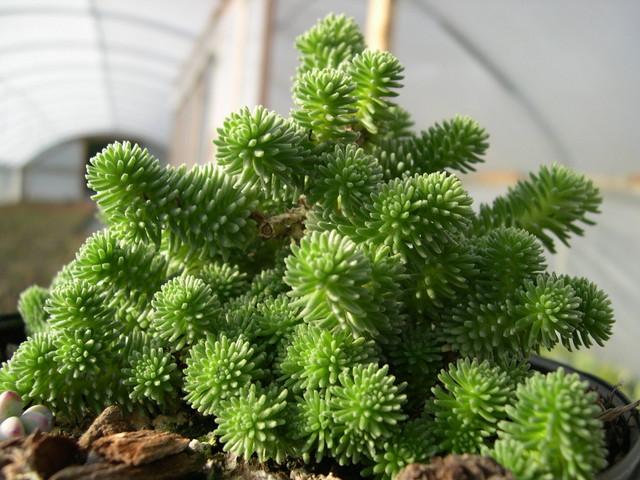
Tips for Planting Sedums
Sedum is easily planted. For shorter varieties, simply laying the plant on the ground where you want it to grow is normally enough to get the plant started there. They will send out roots from wherever the stem is touching the ground and root itself. If you would like to further ensure that the plant will start there, you can add a very thin covering of soil over the plant.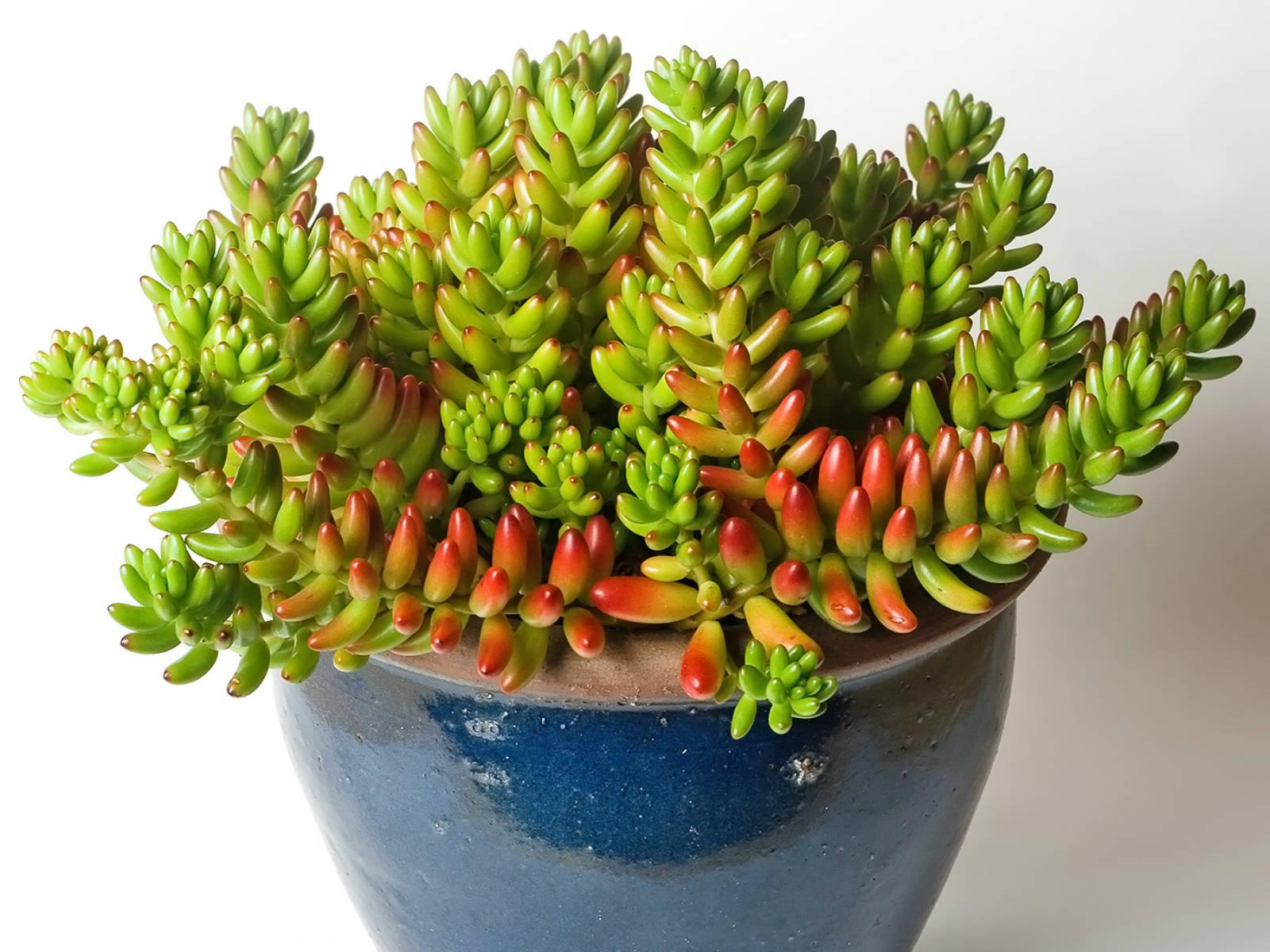
For taller varieties, you can break off one of the stems and push it into the ground where you would like to grow it. The stem will root very easily and anew plant will be established in a season or two.

How to Grow Sedum
When growing Sedum, keep in mind that plants need very little attention or care. They will thrive in conditions that many other plants thrive in, but will do just as well in less hospitable areas. They are ideal for that part of your yard that gets too much sun or too little water to grow anything else. A common name for Sedum is Stonecrop, due to the fact that many gardeners joke that only stones need less care and live longer.

Sedum varieties vary in height. The smallest are just a few inches tall, and the tallest can be up to 3 feet (90 cm). The large majority of varieties are shorter and they are frequently used as ground covers in xeriscape gardens or rock gardens.

Sedum varieties also vary in their hardiness. Many are hardy to USDA zone 3, while others need a warmer climate. Make sure the Sedum that you plant is suited to your hardiness zone.
Sedums need no additional water or fertilizer. Overwatering and overfertilizing can hurt the plants far worse than not watering or fertilizing.

Tips for Planting Sedums
Sedum is easily planted. For shorter varieties, simply laying the plant on the ground where you want it to grow is normally enough to get the plant started there. They will send out roots from wherever the stem is touching the ground and root itself. If you would like to further ensure that the plant will start there, you can add a very thin covering of soil over the plant.

For taller varieties, you can break off one of the stems and push it into the ground where you would like to grow it. The stem will root very easily and anew plant will be established in a season or two.
2
5
文章
Miss Chen
2017年09月22日

La cola de burro o cola de borrego, Sedum morganianum, es una suculenta perteneciente a la familia de las Crasuláceas. Es originaria de México y resulta muy fácil de cultivar. Queda muy decorativa si la usamos en cestas colgantes pues es una plaza que no tiene el tallo erecto y tiene una bonita caída. Se cultiva en interior precisamente por esa vertiente decorativa.
Sus hojas son casi cilíndricas y de un color verde o verde grisáceo. Es muy resistente y para su cultivo precisamos un suelo típico de las plantas de su familia. El sustrato para cactus será la opción más sencilla aunque podemos preparar nuestra propia mezcla con sustrato universal, perlita y arena a partes iguales. Ya la cultivemos en maceta o en el suelo debe contar con un buen drenaje, sus raíces se pudren con gran facilidad por el exceso de humedad.

Aunque le gustan los ambientes luminosos no tolera bien el sol directo que la reseca en exceso y le hace perder ese bonito color verde que la caracteriza. Le aportaremos fertilizante dos o tres veces al año. Cuando nuestro Sedum ya haya crecido mucho precisará que la cambiemos a una maceta mayor. De todos modos es conveniente cambiarla de maceta cada dos años aproximadamente para renovar el sustrato.

Podemos aprovechar el trasplante para dividir la planta, durante esta operación seguro que además se desprenderán algunas hojas. Éstas nos sirven para reproducirla por esquejes de hoja, tienen una gran facilidad para enraizar. Ya la cultivemos en el suelo, en maceta o en una cesta colgante nos dará grandes satisfacciones por su facilidad de cultivo, bajo mantenimiento y por su alto valor ornamental.
Sus hojas son casi cilíndricas y de un color verde o verde grisáceo. Es muy resistente y para su cultivo precisamos un suelo típico de las plantas de su familia. El sustrato para cactus será la opción más sencilla aunque podemos preparar nuestra propia mezcla con sustrato universal, perlita y arena a partes iguales. Ya la cultivemos en maceta o en el suelo debe contar con un buen drenaje, sus raíces se pudren con gran facilidad por el exceso de humedad.

Aunque le gustan los ambientes luminosos no tolera bien el sol directo que la reseca en exceso y le hace perder ese bonito color verde que la caracteriza. Le aportaremos fertilizante dos o tres veces al año. Cuando nuestro Sedum ya haya crecido mucho precisará que la cambiemos a una maceta mayor. De todos modos es conveniente cambiarla de maceta cada dos años aproximadamente para renovar el sustrato.

Podemos aprovechar el trasplante para dividir la planta, durante esta operación seguro que además se desprenderán algunas hojas. Éstas nos sirven para reproducirla por esquejes de hoja, tienen una gran facilidad para enraizar. Ya la cultivemos en el suelo, en maceta o en una cesta colgante nos dará grandes satisfacciones por su facilidad de cultivo, bajo mantenimiento y por su alto valor ornamental.
0
0
成长记
Ueca
2017年09月20日

A little glass I have adorned with various revived garden scraps. In there are Sempervivum tectorum, Sedum sexangulare, a type of Crassula, and an (I suspect) Echeveria runyonii. The glass is just over 7 cm (under 3 inches) in diameter.


5
1
文章
Dummer. ゛☀
2017年09月20日

If you are planting winter-hardy varieties, such as Sedum sp., Hens and Chicks (Sempervivum sp.), Ice Plant (Delosperma sp.), Yucca (Yucca sp.), you shouldn’t have to worry about any extra winter care. You may see them begin to wither, shrink, or change color as cold weather approaches, but this is part of their normal winter routine. These plants withstand freezing temperatures, with some varieties hardy down to zone 3. 
For less hardy varieties, the problem during the winter is the deadly combination of cold temperatures and waterlogged, soggy soil from rains and snow melt. Many varieties will withstand colder temperatures if the soil can be kept dry enough. Some tips for caring for tender succulents during freezing weather include:
Keep the soil as dry as possible. Stop supplemental watering and feeding around late fall.
Be sure there is adequate air circulation, to keep the winter dampness at bay.
Plant succulents in sheltered areas if your winters are rainy – a good spot might be a sunny location underneath the eaves or porch.
Make sure your soil has good drainage – if you notice soggy soil around your succulents during wet weather, you need to improve the conditions to help your plant survive. Add sand, well-draining organic matter, or a product such as Perma-Till to increase water drainage.
Cover tender plants when freezing temperatures are forecasted. You can use fabric covers, bushel baskets, or purchased frost covers. Just make sure the covers do not touch the leaves, and don’t keep them covered any longer than necessary – they need air circulation and sunlight.
Don’t remove snow cover – it’s a good insulator.

For less hardy varieties, the problem during the winter is the deadly combination of cold temperatures and waterlogged, soggy soil from rains and snow melt. Many varieties will withstand colder temperatures if the soil can be kept dry enough. Some tips for caring for tender succulents during freezing weather include:
Keep the soil as dry as possible. Stop supplemental watering and feeding around late fall.
Be sure there is adequate air circulation, to keep the winter dampness at bay.

Plant succulents in sheltered areas if your winters are rainy – a good spot might be a sunny location underneath the eaves or porch.
Make sure your soil has good drainage – if you notice soggy soil around your succulents during wet weather, you need to improve the conditions to help your plant survive. Add sand, well-draining organic matter, or a product such as Perma-Till to increase water drainage.

Cover tender plants when freezing temperatures are forecasted. You can use fabric covers, bushel baskets, or purchased frost covers. Just make sure the covers do not touch the leaves, and don’t keep them covered any longer than necessary – they need air circulation and sunlight.
Don’t remove snow cover – it’s a good insulator.
0
1
文章
Dummer. ゛☀
2017年09月19日

Sedum morganianum also known as Donkey’s Tailis, is a popular and easy-to-grow trailing succulent with rows of fleshy, tear-dropped shaped leaves. It may also be called Burro’s Tail, Lamb’s Tail, or Horse’s Tail. These plants make excellent hanging subjects, or they can be used as trailers in small pots. A mature specimen might have branches up to 2 feet (60 cm) long, with dozens of grey-green, plump leaves lined up like droplets. Flowers readily emerge in late summer in hanging clusters of small blossoms in red, yellow or white.
Growing Conditions
Light: Full sun. Donkey’s Tail is perfect for a sunny window.
Water: Water during the summer and spring, making sure drainage is immaculate. Reduce water in the winter to monthly.
Temperature: Donkey’s Tail prefers average summer temps (65ºF to 70ºF/18ºC to 21ºC). In winter, can survive at 40ºF (5ºC), but prefers it slightly warmer.
Soil: A well-drained succulent potting soil, with an ideal pH around 6.0 (slightly acidic).
Fertilizer: Feed Donkey’s Tail with a controlled-release fertilizer in the beginning of the season or weekly with a weak liquid solution. Use a balanced 20-20-20 fertilizer at 1/4 strength on mature plants, and a fertilizer with less nitrogen on young plants.
Repotting
Repot as needed, preferably during the warm season. To repot a Donkey’s Tail, make sure the soil is dry before repotting, then gently remove the pot. Knock away the old soil from the roots, making sure to remove any rotted or dead roots in the process. Treat any cuts with a fungicide. Place the plant in its new pot and backfill with potting soil, spreading the roots out as you repot. Leave the plant dry for a week or so, then begin to water lightly to reduce the risk of root rot.
Propagation
By seed or by cuttings. Individual leaves can be sprouted by placing them into a succulent or cactus potting soil, then covering the dish until they sprout. Large Donkey’s Tail plants can also be divided during repotting.
Grower’s Tips
Donkey’s Tails are pretty forgiving plants—if you forget to water them once or twice, they’ll probably be just fine. If you want your plant to really thrive, make sure to provide strong light, fertilizer during the growing season, and adequate moisture during the growing season. Too often, these are left to fend for themselves, simply because they can. But with a little effort, the plant can be a remarkable specimen.

Growing Conditions
Light: Full sun. Donkey’s Tail is perfect for a sunny window.
Water: Water during the summer and spring, making sure drainage is immaculate. Reduce water in the winter to monthly.
Temperature: Donkey’s Tail prefers average summer temps (65ºF to 70ºF/18ºC to 21ºC). In winter, can survive at 40ºF (5ºC), but prefers it slightly warmer.
Soil: A well-drained succulent potting soil, with an ideal pH around 6.0 (slightly acidic).
Fertilizer: Feed Donkey’s Tail with a controlled-release fertilizer in the beginning of the season or weekly with a weak liquid solution. Use a balanced 20-20-20 fertilizer at 1/4 strength on mature plants, and a fertilizer with less nitrogen on young plants.

Repotting
Repot as needed, preferably during the warm season. To repot a Donkey’s Tail, make sure the soil is dry before repotting, then gently remove the pot. Knock away the old soil from the roots, making sure to remove any rotted or dead roots in the process. Treat any cuts with a fungicide. Place the plant in its new pot and backfill with potting soil, spreading the roots out as you repot. Leave the plant dry for a week or so, then begin to water lightly to reduce the risk of root rot.

Propagation
By seed or by cuttings. Individual leaves can be sprouted by placing them into a succulent or cactus potting soil, then covering the dish until they sprout. Large Donkey’s Tail plants can also be divided during repotting.

Grower’s Tips
Donkey’s Tails are pretty forgiving plants—if you forget to water them once or twice, they’ll probably be just fine. If you want your plant to really thrive, make sure to provide strong light, fertilizer during the growing season, and adequate moisture during the growing season. Too often, these are left to fend for themselves, simply because they can. But with a little effort, the plant can be a remarkable specimen.
0
1
成长记
lensucc
2017年09月01日

I new added a "Sedum rubrotinctum" in my "garden"
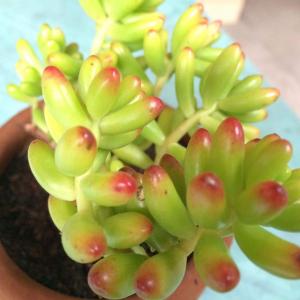

2
0
lensucc:@Ophelia Darke thank youuuu ❤
Ophelia Darke:So cute! I love how it looks like it's blushing



